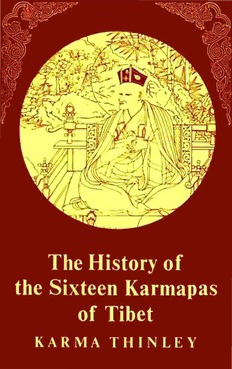
The History of the Sixteen Karmapas of Tibet PDF
Preview The History of the Sixteen Karmapas of Tibet
The History of the Sixteen Karmapas of Tibet The History of the Sixteen Karmapas of Tibet KARMA THINLEY The Fourth Karma Thinleypa Edited with an essay by David Stoll !llustrated by Namkha Tashi Foreword by Chogyam Trungpa Introduction by Reginald A. Ray 1980 Prajfia Press BOULDER Praji\!l Press Great Eastern Book Company P.O. Box 271 Boulder, Colorado 80306 c 1980 Norbu Publications ISBN 0..87773-716-9 Printed in the United States of America Library of Congress Cataloging in Publication Data Karma Thinley, Lama Wangchhim. The history of the sixteen Karma pas of Tibet. I. Kar-ma-pa lamas-Tibet-Biography. 2. Kar-ma-pa (Sect)-History. I. Stott, David II. Title. BQ7682.9.A2K285 294.3'61'0922 80-179 ISBN 0-87773-716-9 CONTENTS Foreword Vll Preface viii Introduction I The Historical and Theoretical Background 2I I. Karmapa Dusum Khyenpa 4I 2. Karmapa Karma Pakshi 47 3. Karmapa Rangjung Dorje 55 4. Karmapa Rolpe Dorje 61 5. Karmapa Dezhin Shegpa 71 6. Karmapa Thongwa Donden 79 7. Karmapa Chodrag Gyatsho 83 8. Karmapa Mikyo Dorje 89 9. Karmapa Wangchuk Dorje 97 10. Karmapa Choying Dorje 103 11. Karmapa Ye she Dorje 109 12. Karmapa Changchub Dorje 113 13. Karmapa Dudul Dorje 117 14. Karmapa Thegchog Dorje 121 15. Karmapa Khakhyab Dorje 125 I6. Karmapa Rangjung Rigpe Dorje 129 Notes 137 Glossary 143 Bibliography 150 FOREWORD THE PRACTICING LINEAGE of the Kagyu tradition remains the crown jewel of the contemplative Buddhist world. The examples and life styles of great teachers of this tradition have inspired countless practitioners, such that their lives could be further devoted to meditative disciplines. The Karma pas are particularly the great pillars of the Kagyu tradition, who have enabled the practicing lineage to continue in spite of political, social and economic obstacles. Karma Thinley, Rinpoche, is a very close lriend and student of mine. I appreciate his insight and wisdom in revealing to us the true stories of the lineage of the Karmapas. No doubt this book will benefit its readers; they should read it with inspiration and devotion. I remain a servant and propagator of the Kagyu tradition, Chogyam Trungpa Vajracarya the Venerable Chogyam Trungpa, Rinpoche Boulder, Colorado 21 February 1980 vii PREFACE H1he teachings of the Karmapas will last as long as the teachings ofa thousand Buddhas." -Karma Pakshi THE GREAT TERTON, Chogyur Lingpa. predicted that the sixteenth or seventeenth Karmapa would one day cross the ocean. True to his prediction the teachings of the sixteenth Karmapa have spread to reach the Western conti nent. In fact, Gyalwa Karmapa has now traveled twice around the world and given teachings and initiations to many followers and established numerous Kagyu centers. In Tibet there were nine Buddhist sects that followed the teachings ofthe hinayilna, mahayilna and vajrayiJna: Gelugpa. founded by the Mafijusri emana tion, Tsongkhapa; Nyingmapa, founded by Vajracarya Padmasambhava. King Trisong Detsun and Abbot Santara~ita; Kadampa, founded by AtiSa and Gyalwa Dromtonpa; Sakyapa. founded by Drogmi Lotsawaand Konchog Gyalpo; Kagyupa, founded by Naropa and Marpa Lotsawa; Chod (. . Cutting Through Ego"), founded by the lady siddha, Machig Labkyi Dronma; Shijay (. . Pacifying Suffering"), founded by Dampa Sangye; Shangpa Kagyu, founded by Khyungpo Naljor; and the Urgyen Nyendrup, founded by the mahiJsiddha and pDIJI!ita, Urgyenpa Rinchen Pal. At present surviving in strength are the Gelugpa, Sakyapa. Kagyupa and Nyingmapa. All follow the same basic teachings of Buddhism brought from India to Tibet at the price of great material and human resources over the centuries. Basically all of these sects are holders of vajrayiJna transmissions from Vajradhara and passed down to the guru. The lama is in fact a manifestation of Vajradhara and, therefore, of very great importance. That is why in the past Tibetan Buddhism has been referred to by some as .. Iamaism." The term refers to this aspect of Tibetan Buddhism. If you study one sect then you will understand all sects. There are no important differences in their teachings. A Tibetan proverb says that when you viii
